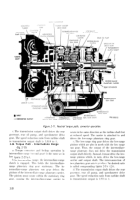TM-9-2520-254-34 - Page 47 of 126
CHAPTER 4
TROUBLESHOOTING
4-1. Purpose and General Instructions
NOTE
Information in this chapter is for use of
Ordnance maintenance personnel, in
conjunction with and as a supplement to
the troubleshooting section of end item
organization manual. It provides con-
tinuation of instruction where a remedy in
the organizational maintenance manual
refers to Ordnance maintenance personnel
for corrective action.
a.
Operation of a deadlined vehicle without a
preliminary examination can cause further damage
to a component and possible injury to personnel. By
careful inspection
and
troubleshooting,
such
damage and injury can be avoided. In addition, the
cause of faulty operation of a vehicle or component
can
often be determined without extensive
disassembly.
NOTE
This chapter contains inspection and
troubleshooting procedures to be per-
formed while a disabled component is still
mounted in the vehicle as well as after it
has been removed.
b.
The inspections made while the component is
mounted in the vehicle are, for the most part, visual
and are to be performed before attempting to
operate the vehicle. The object of these inspections
is to determine the condition of the component and,
if found defective, to take precautions to prevent
further damage.
c. The troubleshooting performed while the
component is mounted in the vehicle is that which
is beyond the normal scope of the using
organization. Check the troubleshooting section of
end item organizational manual, then proceed as
outlined in this chapter.
d.
If the component alone is received by the
Ordnance establishment, inspection should be
performed to verify the diagnosis made when the
component was in the vehicle. This inspection, to
uncover further defects, or to determine malfunc-
tions, is particularly important because it is often
the only means of determining the malfunction
without complete disassembly of the component.
4-2. Operating Characteristics
To perform effective troubleshooting, the mechanic
must have a thorough knowledge of—
a. Construction Features.
Refer to paragraphs 2-
1 through 2-11 for description and function of the
transmission components.
b.
Functions
of Components.
Refer to
paragraphs 2-12 through 2-26 for explanations of
hydraulic operations and power flow through the
transmission components.
c. Operating Instructions.
Refer to end item
operator’s manual for instructions on operating the
transmission while driving the vehicle in which it is
installed.
d. Oil Supply.
Refer to paragraph 1-6 for oil
supply information.
e. Adjustments.
Refer to paragraph 5-63 for
adjustment procedures.
f. Oil Pressures.
Refer to table 1-1, paragraph 1-
7, for oil pressures.
4-3. Troubleshooting—Before Removal or Op-
eration
a.
Do not operate the vehicle prior to completing
the procedures described in this paragraph. Refer
to paragraph 4-1 for the purpose of these in-
spections.
Inspect for oil leakage.
Visually inspect
all split-lines, connections, covers, output shaft, and
plugs for oil leaks. Oil leakage at split-lines may be
caused by loose bolts or defective gaskets. Tighten
bolts where leakage is found. If leaks continue,
install new gaskets.
NOTE
Inspect transmission again for oil leakage
after starting vehicle engine (para 4-4).
b.
Inspect transmission assembly for loose
components and loose, disconnected, or damaged
linkage. Check linkage and operator’s controls for
damage, wear, binding, or improper adjustment.
Proper adjustment and operation of shift and
throttle control linkage are essential to efficient
performance of the transmission.
4-4. Troubleshooting—Before Removal and
During Operation
a. General.
If the inspections in paragraph 4-3 do
not reveal the cause of failure, and the vehicle is
operable, further troubleshooting is necessary. Do
not remove the transmission from the vehicle until
the causes of trouble listed in table 4-1 are checked.
Refer to paragraph 4-3 for the purposes and scope
of these troubleshooting procedures. To make a
thorough check of transmission performance, be
sure the vehicle engine is properly tuned and that
the transmission oil level is correct (para 1-6).
Inspect again for oil leaks after starting engine.
b. Troubleshooting
Table.
This condensed
troubleshooting information will assist mechanics
in diagnosing and correcting malfunctions in the
4-1
Back to Top




















